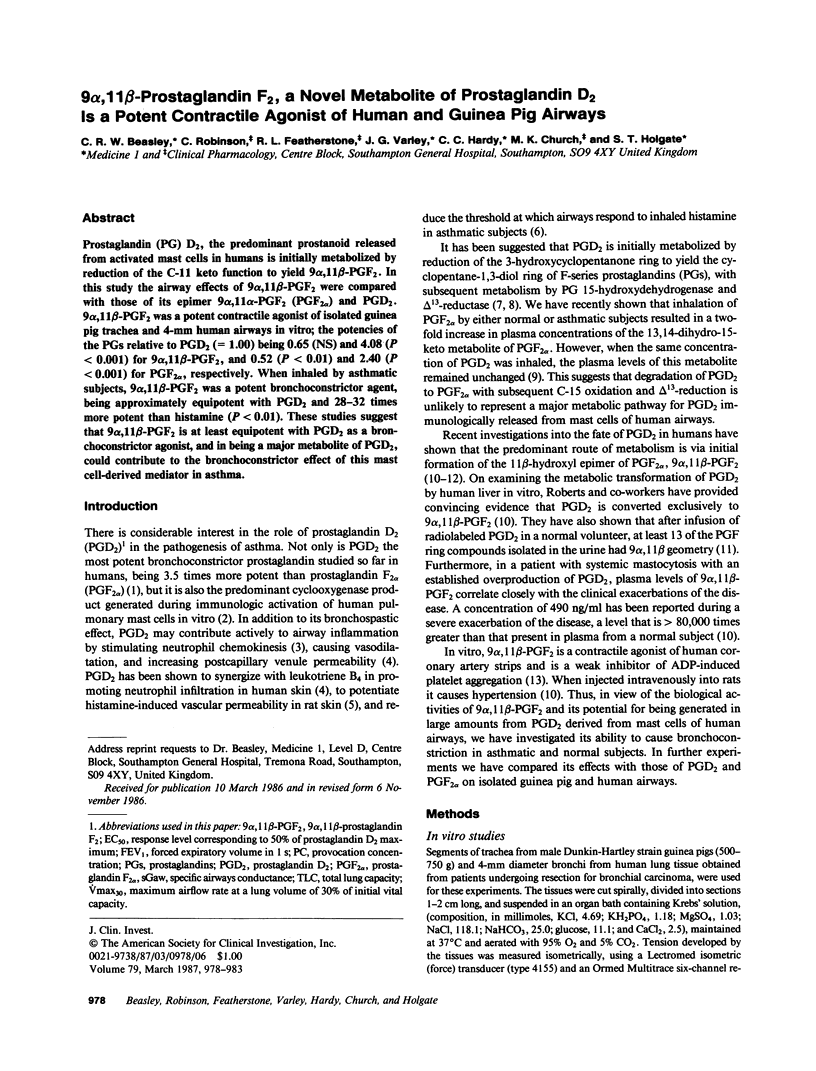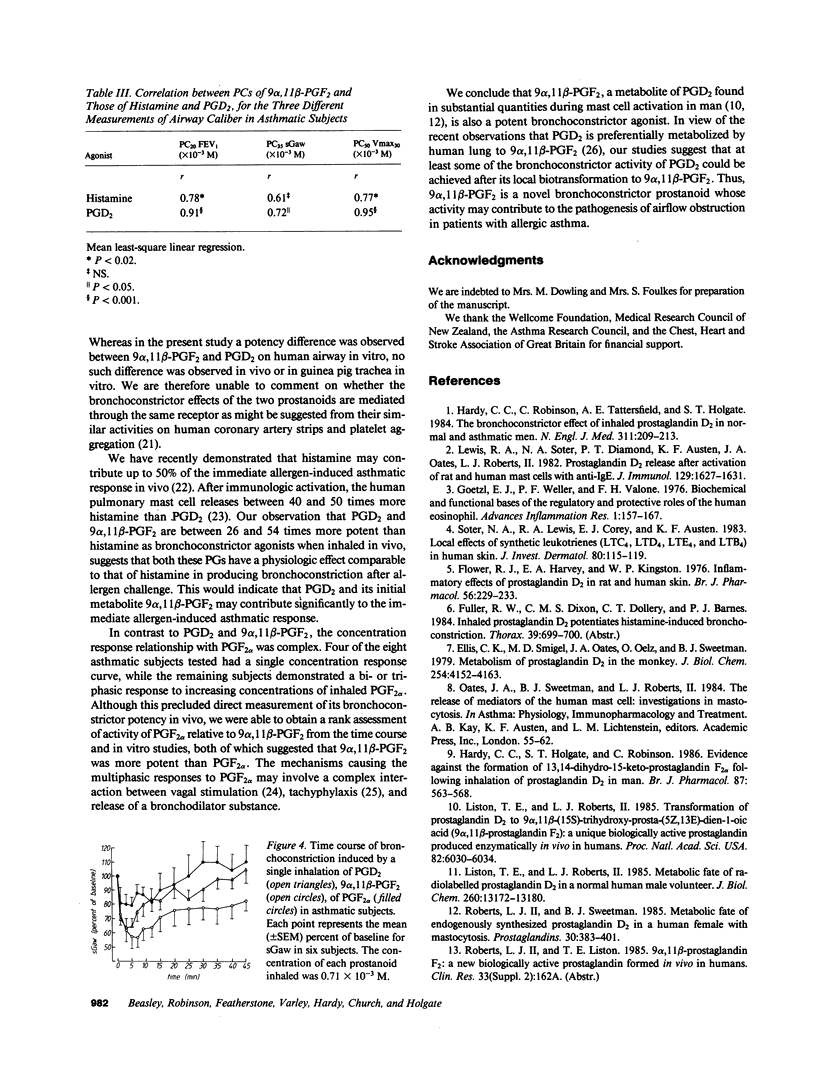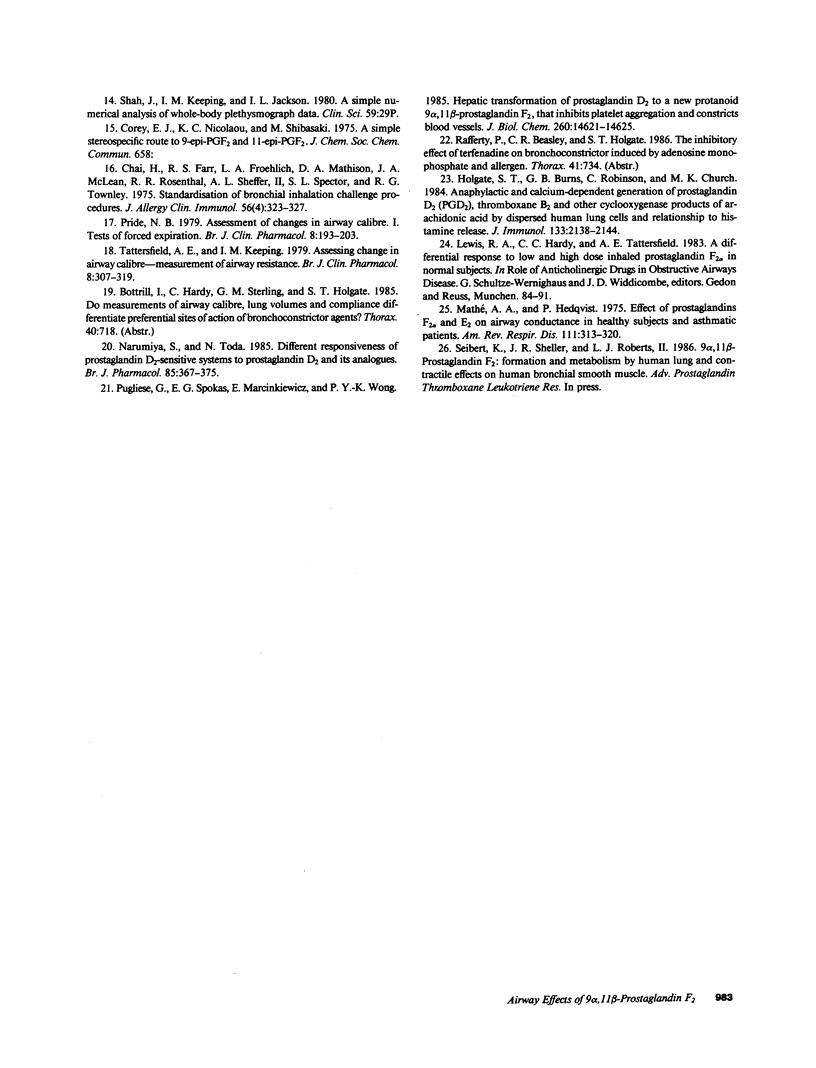Abstract
Prostaglandin (PG) D2, the predominant prostanoid released from activated mast cells in humans is initially metabolized by reduction of the C-11 keto function to yield 9 alpha,11 beta-PGF2. In this study the airways effects of 9 alpha,11 beta-PGF2 were compared with those of its epimer 9 alpha,11 alpha-PGF2 (PGF2 alpha) and PGD2. 9 alpha,11 beta-PGF2 was a potent contractile agonist of isolated guinea pig trachea and 4-mm human airways in vitro; the potencies of the PGs relative to PGD2 (= 1.00) being 0.65 (NS) and 4.08 (P less than 0.001) for 9 alpha,11 beta-PGF2, and 0.52 (P less than 0.01) and 2.40 (P less than 0.001) for PGF2 alpha, respectively. When inhaled by asthmatic subjects, 9 alpha,11 beta-PGF2 was a potent bronchoconstrictor agent, being approximately equipotent with PGD2 and 28-32 times more potent than histamine (P less than 0.01). These studies suggest that 9 alpha,11 beta-PGF2 is at least equipotent with PGD2 as a bronchoconstrictor agonist, and in being a major metabolite of PGD2, could contribute to the bronchoconstrictor effect of this mast cell-derived mediator in asthma.
Full text
PDF





Selected References
These references are in PubMed. This may not be the complete list of references from this article.
- Chai H., Farr R. S., Froehlich L. A., Mathison D. A., McLean J. A., Rosenthal R. R., Sheffer A. L., Spector S. L., Townley R. G. Standardization of bronchial inhalation challenge procedures. J Allergy Clin Immunol. 1975 Oct;56(4):323–327. doi: 10.1016/0091-6749(75)90107-4. [DOI] [PubMed] [Google Scholar]
- Ellis C. K., Smigel M. D., Oates J. A., Oelz O., Sweetman B. J. Metabolism of prostaglandin D2 in the monkey. J Biol Chem. 1979 May 25;254(10):4152–4163. [PubMed] [Google Scholar]
- Flower R. J., Harvey E. A., Kingston W. P. Inflammatory effects of prostaglandin D2 in rat and human skin. Br J Pharmacol. 1976 Feb;56(2):229–233. doi: 10.1111/j.1476-5381.1976.tb07446.x. [DOI] [PMC free article] [PubMed] [Google Scholar]
- Hardy C. C., Holgate S. T., Robinson C. Evidence against the formation of 13,14-dihydro-15-keto-prostaglandin F2 alpha following inhalation of prostaglandin D2 in man. Br J Pharmacol. 1986 Mar;87(3):563–568. doi: 10.1111/j.1476-5381.1986.tb10198.x. [DOI] [PMC free article] [PubMed] [Google Scholar]
- Hardy C. C., Robinson C., Tattersfield A. E., Holgate S. T. The bronchoconstrictor effect of inhaled prostaglandin D2 in normal and asthmatic men. N Engl J Med. 1984 Jul 26;311(4):209–213. doi: 10.1056/NEJM198407263110401. [DOI] [PubMed] [Google Scholar]
- Holgate S. T., Burns G. B., Robinson C., Church M. K. Anaphylactic- and calcium-dependent generation of prostaglandin D2 (PGD2), thromboxane B2, and other cyclooxygenase products of arachidonic acid by dispersed human lung cells and relationship to histamine release. J Immunol. 1984 Oct;133(4):2138–2144. [PubMed] [Google Scholar]
- Kermode J. C., Edmonds C. J. Pathways of transepithelial potassium movement in the epithelium of distal colon in man. Clin Sci (Lond) 1980 Jul;59(1):29–39. doi: 10.1042/cs0590029. [DOI] [PubMed] [Google Scholar]
- Lewis R. A., Soter N. A., Diamond P. T., Austen K. F., Oates J. A., Roberts L. J., 2nd Prostaglandin D2 generation after activation of rat and human mast cells with anti-IgE. J Immunol. 1982 Oct;129(4):1627–1631. [PubMed] [Google Scholar]
- Liston T. E., Roberts L. J., 2nd Metabolic fate of radiolabeled prostaglandin D2 in a normal human male volunteer. J Biol Chem. 1985 Oct 25;260(24):13172–13180. [PubMed] [Google Scholar]
- Liston T. E., Roberts L. J., 2nd Transformation of prostaglandin D2 to 9 alpha, 11 beta-(15S)-trihydroxyprosta-(5Z,13E)-dien-1-oic acid (9 alpha, 11 beta-prostaglandin F2): a unique biologically active prostaglandin produced enzymatically in vivo in humans. Proc Natl Acad Sci U S A. 1985 Sep;82(18):6030–6034. doi: 10.1073/pnas.82.18.6030. [DOI] [PMC free article] [PubMed] [Google Scholar]
- Mathé A. A., Hedqvist P. Effect of prostaglandins F2 alpha and E2 on airway conductance in healthy subjects and asthmatic patients. Am Rev Respir Dis. 1975 Mar;111(3):313–320. doi: 10.1164/arrd.1975.111.3.313. [DOI] [PubMed] [Google Scholar]
- Narumiya S., Toda N. Different responsiveness of prostaglandin D2-sensitive systems to prostaglandin D2 and its analogues. Br J Pharmacol. 1985 Jun;85(2):367–375. doi: 10.1111/j.1476-5381.1985.tb08870.x. [DOI] [PMC free article] [PubMed] [Google Scholar]
- Pride N. B. Assessment of changes in airway calibre I. Tests of forced expiration. Br J Clin Pharmacol. 1979 Sep;8(3):193–203. doi: 10.1111/j.1365-2125.1979.tb01002.x. [DOI] [PMC free article] [PubMed] [Google Scholar]
- Pugliese G., Spokas E. G., Marcinkiewicz E., Wong P. Y. Hepatic transformation of prostaglandin D2 to a new prostanoid, 9 alpha,11 beta-prostaglandin F2, that inhibits platelet aggregation and constricts blood vessels. J Biol Chem. 1985 Nov 25;260(27):14621–14625. [PubMed] [Google Scholar]
- Roberts L. J., 2nd, Sweetman B. J. Metabolic fate of endogenously synthesized prostaglandin D2 in a human female with mastocytosis. Prostaglandins. 1985 Sep;30(3):383–400. doi: 10.1016/0090-6980(85)90114-5. [DOI] [PubMed] [Google Scholar]
- Soter N. A., Lewis R. A., Corey E. J., Austen K. F. Local effects of synthetic leukotrienes (LTC4, LTD4, LTE4, and LTB4) in human skin. J Invest Dermatol. 1983 Feb;80(2):115–119. doi: 10.1111/1523-1747.ep12531738. [DOI] [PubMed] [Google Scholar]
- Tattersfield A. E., Keeping I. M. Assessing change in airway calibre--measurement of airway resistance. Br J Clin Pharmacol. 1979 Oct;8(4):307–319. doi: 10.1111/j.1365-2125.1979.tb04711.x. [DOI] [PMC free article] [PubMed] [Google Scholar]


